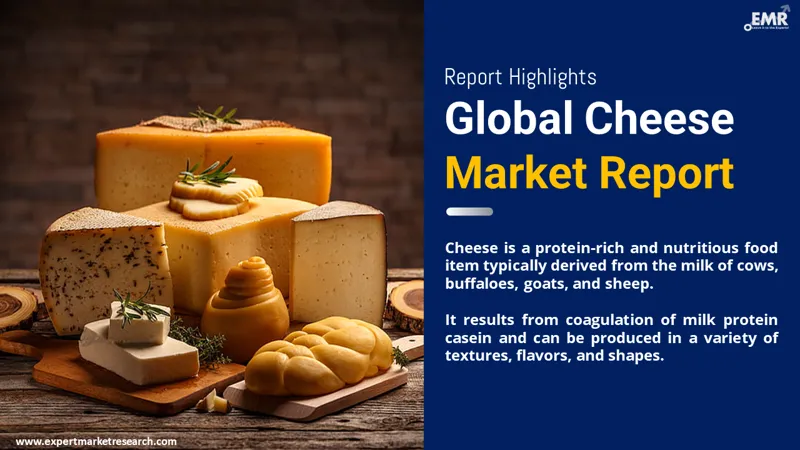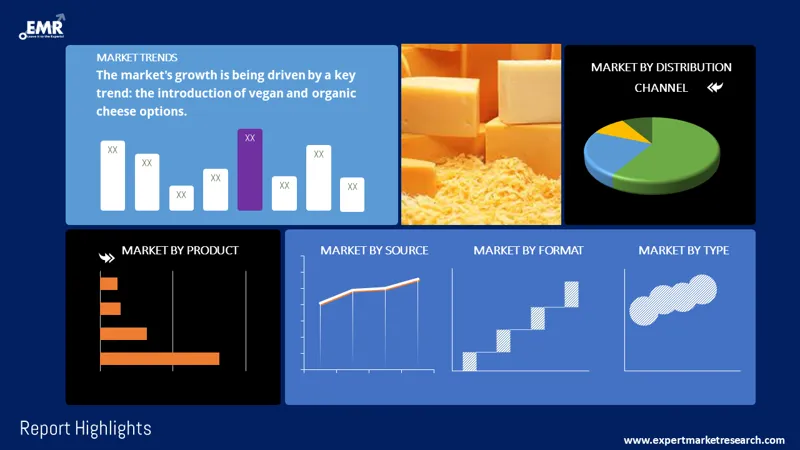
Consumer Insights
Uncover trends and behaviors shaping consumer choices today
Procurement Insights
Optimize your sourcing strategy with key market data
Industry Stats
Stay ahead with the latest trends and market analysis.
Trending Now



The global cheese market is expected to reach a value of more than USD 102.09 Billion in 2024. The industry is expected to grow at a CAGR of 7.80% during the forecast period of 2025-2034. The growing demand for natural, organic, and artisanal cheeses, driven by health-conscious consumers, is propelling the cheese market. As a result of this augment demand, the market is set to attain a valuation of USD 216.36 Billion by 2034.
Base Year
Historical Year
Forecast Year






Value in USD Billion
2025-2034
Cheese Market Outlook
*this image is indicative*
| Global Cheese Market Report Summary | Description | Value |
| Base Year | USD Billion | 2024 |
| Historical Period | USD Billion | 2018-2024 |
| Forecast Period | USD Billion | 2025-2034 |
| Market Size 2024 | USD Billion | 102.09 |
| Market Size 2034 | USD Billion | 216.36 |
| CAGR 2018-2024 | Percentage | XX% |
| CAGR 2025-2034 | Percentage | 7.80% |
| CAGR 2025-2034 - Market by Region | Asia Pacific | 9.0% |
| CAGR 2025-2034 - Market by Country | India | 9.4% |
| CAGR 2025-2034 - Market by Country | China | 8.6% |
| CAGR 2025-2034 - Market by Source | Cow Milk | 8.9% |
| CAGR 2025-2034 - Market by Type | Processed | 8.1% |
| Market Share by Country 2024 | Italy | 2.6% |
The cheese market is also experiencing a great growth trend, considering the evolving consumer preferences towards healthier and more sustainable options. This market is primarily witnessing growth in the demand for plant-based and organic cheeses. This is due to an increase in veganism and health-conscious diets. Growing interest in artisanal and specialty cheeses is also experienced, where consumers seek unique flavors and premium quality.

Read more about this report - REQUEST FREE SAMPLE COPY IN PDF
In line with these trends, companies innovate by offering plant-based alternatives and organic offerings. In the cheese-making industry, for instance, there is a drive toward sustainability, such as packaging in more eco-friendly ways and reducing waste in production processes. Premium, customized products have increased consumer demand, which brands are investing in through premium cheese lines and unique varieties, thus boosting the global cheese demand.
Moreover, with the increased demand for convenience, companies are improving their distribution channels, including e-commerce platforms, to make their products more accessible to a wider audience. Such strategic shifts are helping companies capture new markets and satisfy changing consumer preferences.
The global cheese market is growing at a strong pace, driven by a number of key factors. The most important factor has been the increasing demand for varied cheese products from consumers in fast food and ready-to-eat meals. Due to the increasing rate of urbanization, consumers have fewer hours to spend in cooking at home, which means they prefer convenience foods that have cheese in them. Increased disposable incomes have also increased the number of people dining out and enjoying cheese-based foods at restaurants, which also boosts demand of the cheese market.
Cheese is also known for its nutritional value, offering a rich source of protein, calcium, and important vitamins, making it an integral part of many diets across the globe. The increase in awareness of these health benefits has led to a higher consumption rate across all ages. Additionally, there has been an increased interest in gourmet and specialty cheeses that are being sought by consumers due to their unique flavors and premium experiences. Expanding this market are innovative product development such as plant-based cheeses and low-fat varieties.
Plant-based cheeses, gourmet options, functional benefits, and sustainability drive innovation and growth in the cheese industry.
Plant-based and dairy-free cheeses have gained the popularity with growing demand for vegan and dairy-free products: The market for cheese has witnessed the rise of plant-based cheeses. Brands like Violife and Daiya have been offering a plethora of dairy-free cheese options, mainly for consumers suffering from lactose intolerance and for people following plant-based diets. These cheeses are made from nuts, soy, or coconut oil and are gaining popularity not only for their dietary benefits but also for their environmental impact. The demand for vegan products is forcing companies to innovate and expand their dairy-free offerings, thus augmenting the cheese demand growth.
Consumers are looking for high-quality, unique cheese products, which has led to an increase in gourmet and artisanal cheeses. Generally made by hand in small batches from the finest ingredients, most of these cheeses have such unique flavors and textures which mass-produced cheeses cannot create. Brands such as Cowgirl Creamery and Murray's Cheese are capitalizing on this trend, churning out an array of high-premium products. This swing toward high-end, local cheeses is part of an entire consumer movement toward better quality, sustainability, and genuine food experiences.
As consumers continue to become more health conscious, cheese products that provide functional benefits are gaining in popularity. These include cheeses containing probiotics for digestive health, low-fat or reduced-sodium options, and those with added vitamins or minerals. For instance, probiotic cheeses from such companies as Emmi and Lifeway Foods are fast gaining popularity due to their purported benefits for digestive health. This trend is indicative of consumers gravitating toward functional foods where taste and health advantage meet, which is what pushes the demand for the novelty cheese products with beneficial healthy effects, thus boosting the cheese market revenue.
Sustainability is becoming a focus for the cheese industry, with companies adopting more eco-friendly practices in production, packaging, and sourcing. Consumers are increasingly concerned about the environmental impact of their food choices, driving demand for cheese made with ethical sourcing and sustainable production methods. For example, Green Valley Creamery focuses on organic, sustainable farming practices for its dairy products. Brands are also using biodegradable packaging and reducing carbon emissions while adopting the fast-growing trend of environmentally conscious consumerism. This emphasis on sustainability is helping companies mark out a niche in such a competitive world.
One trend dominating the global cheese market, especially in North America and Europe, is the increase in demand for natural and clean-label cheeses. The consumer is becoming increasingly health-conscious and is expecting more from the ingredients in the food they consume. They prefer cheeses with fewer additives and preservatives. Cabot Creamery and Organic Valley are among the brands taking advantage of such a trend-organic, non-GMO, and no additive cheese products. These companies emphasize the transparency of their labeling to allow consumers to make an informed decision about the quality and purity of their products. Furthermore, lactose-free and artisanal cheeses are in increased demand as consumers opt for healthier and more specialized offerings that meet their dietary preferences, thus shaping new trends in the cheese market.
Convenience is another driver in cheese consumption, and pre-sliced or ready-to-eat formats are gaining popularity. Companies like Sargento and Bel Group have launched cheese snacks and pre-sliced cheese packs to meet the needs of the busy, on-the-go consumer. These innovations meet consumer demand for health-conscious and convenient cheese products, thereby driving growth in the market.
An enormous opportunity in the global market for cheese arises from the increasing demand for artisanal and specialty cheeses, shaping cheese market opportunities. Consumers are becoming increasingly health-conscious and willing to pay more for products made from organic and sustainable sources. Thus, as consumers look for more unique, high-quality cheese experiences, brands will have the opportunity to grow their offerings in premium and artisanal categories. For instance, blue cheese and organic cheeses have become a success because of their application and appeal to health-conscious buyers.
Precision fermentation is one of the major technologies increasing cheese demand and boosting the cheese market dynamics and trends. This new method permits more efficient, sustainable ways of producing dairy proteins by not involving animals. Companies, such as Perfect Day, use precision fermentation to create proteins that closely mirror those within traditional cheeses. This capability allows the company to build dairy-free cheeses that provide the same taste and mouthfeel of their traditional counterparts. It caters to the growing market for plant-based and sustainable food alternatives, marking new opportunities.

Read more about this report - REQUEST FREE SAMPLE COPY IN PDF
“Cheese Market Report and Forecast 2025-2034” offers a detailed analysis of the market based on the following segments:
Market Breakup by Source:
Market Breakup by Type:
Market Breakup by Product:
Market Breakup by Distribution Channel:
Market Breakup by Format:
Market Breakup by Region
By Source Analysis
Global demand for cow's milk cheese remains high as cows' milk is the most popular source for milk in cheese manufacturing. The segment also includes an assortment of cheeses that vary greatly by type, texture, taste, and customer preference. There is a whole spectrum of cheeses available on the market, including fresh, soft cheeses such as Mozzarella and Brie and aged, hard cheeses, such as Cheddar and Parmigiano-Reggiano.
Cheese is a staple in many Western diets and is increasingly being incorporated into culinary traditions worldwide. Cow's milk cheese, in particular, is often preferred for its familiar taste and wide availability. The processed food sector, including frozen meals, snacks, and ready-to-eat products, heavily utilises cow's milk cheese, contributing to its consistent demand.
Market Analysis by Type
Natural cheese accounts for an important market share in the cheese market, based on cheese market analysis. The demand of natural cheese in the market is vast and in turn increases due to consumer's awareness toward authentic, quality and flavor-rich products. Natural cheese, on the other hand, is any type of cheese prepared directly from milk and kept as much minimally processed and without using artificial preservatives, colours, or flavour.
As consumers are becoming more health-conscious, the demand for natural and wholesome foods is increasing. Natural cheese is perceived to be a healthier alternative because of minimal processing and no artificial additives. Additionally, consumers are willing to pay a premium for natural cheeses that offer unique flavors, origins, and artisanal qualities.
Product Insights
Mozzarella cheese is widely recognized as one of the most used and liked cheeses in the market due to its mild flavor and high melting properties. Several factors have an influence on demand, ranging from culinary trends to diverse applications. Mozzarellas are quintessential components of pizzas, which are popular in fast food and casual dining outlets. The melting qualities and neutral taste of this cheese suit a wide range of pizza styles.
In addition to pizza, Mozzarella is used in other dishes such as lasagna, salads (such as Caprese), sandwiches, and appetizers. Its wide application in various cuisines is the reason for its high demand. The ready-to-eat and convenience food industries are also on the rise, which involves using Mozzarella in frozen meals, pre-cooked snacks, and meal packages.
Distribution Channel Analysis
According to cheese industry analysis, the product has sold the most in supermarkets and hypermarkets. Supermarkets and hypermarkets have a wide choice of cheese products, which range from simple, everyday versions to gourmet and specialty cheeses, accommodating a wide range of consumer preference and budgets.
Such retail giants usually employ promotional activities such as discounts, tasting events, and pairing recommendations that may directly influence the purchasing decision of the consumer and enhance the sales of cheese. In addition, information labels and knowledgeable in-store staff may educate consumers on the types of cheese, their origin, and uses, and encourage consumers to explore new varieties. Many supermarkets and hypermarkets now offer their private label cheese products which provide quality cheese at competitive prices and private labels can be a strong competitor to established brands of cheese.
Market Insights by Format
Slices account for the market segment that defines products containing pre-sliced cheese, highly consumed as these can be easily used. This gives pre-sliced cheese more advantage in terms of convenience when people are busy or need ready options in preparing meals because it has no slicing and portioning, which saves time and labor. Sliced cheese will give equal portions, helpful in uniform sandwich making, cooking, and baking.
Sliced cheese is widely consumed by individual customers and families for home consumption in supermarkets and grocery stores. It is commonly used in sandwiches, burgers, and other fast foods. The food service sector, including restaurants, cafes, and fast-food chains, frequently employs pre-sliced cheese to ensure uniformity and speed in food preparation.
North America Cheese Market Opportunities
The North America cheese market has a strong export demand, reaching a record high, especially in South Korea and Central America. Vermont's initiatives for cheese and the USDA's USD 23 million grants stimulate innovation and increase local dairy processing capacity. These programs assist small farms in marketing and value-added production, which increases market potential. United States cheese exports also benefit from a good international trust and a rising specialty cheese market.
| CAGR 2025-2034 - Market by | Country |
| India | 9.4% |
| China | 8.6% |
| UK | 7.1% |
| USA | 7.0% |
| Italy | 5.5% |
| Canada | XX% |
| Germany | XX% |
| France | XX% |
| Japan | 5.4% |
| Australia | XX% |
| Saudi Arabia | XX% |
| Brazil | XX% |
| Mexico | XX% |
Asia Pacific Cheese Market Trends
Asia Pacific's cheese consumption is rapidly increasing due to urbanization and increasing westernization in diets. Imports are led by Japan and South Korea, which enjoy free-trade agreements with major suppliers. China's cheese demand is growing at over 8% annually, driven by consumer education that makes it versatile. Regional investments in production seek to meet the demand locally while addressing the challenges of import dependency.
Europe Cheese Market Dynamics
Europe remains the world's largest producer of cheese, with the largest production coming from France, Germany, and Italy. The EU subsidies and PDO-protected cheeses preserve traditional markets, while growing lactose-free and plant-based segments adjust to consumer preferences changing. Exports are buoyant despite Brexit-related setbacks, with global recognition for the quality of European cheese helping to sustain trade. Sustainability aims to decrease the emissions of dairy operations.
Middle East and Africa Cheese Market Drivers
Processed cheese demand increases in the Middle East owing to better disposable incomes and expansion of modern retail. The regional government encourages dairy self-sufficiency and puts investments into high-tech production facilities. Africa's market for cheese is growing progressively with more local consumption happening in the urban areas. Trade relations with the U.S. and Europe strengthen supply chain efficiencies.
Latin America Cheese Market Insights
Brazil and Argentina drive Latin America's cheese market growth by utilizing strong milk production. Artisanal cheeses are encouraged through government programs, particularly for export, in Mexico. Fresh and semi-hard cheese consumption increases with growing middle-class affordability. Regional challenges involve improving supply chain inefficiencies to meet growing domestic and export demands.
Innovation, sustainability, and diversification are the main focus of the cheese market players. Market players are launching plant-based cheeses to cater to the vegan and lactose intolerant consumer base. They are also investing in green packaging and sustainable sourcing for environmental concerns. Other key priorities of cheese companies include expansion into emerging markets, leveraging digital platforms for e-commerce, and enhancing production efficiency with advanced technologies. Premium offerings such as artisanal and aged cheeses are also a priority to cater to evolving consumer tastes.
Nestlé SA founded in 1866 and based in Vevey Switzerland provides processed and premium cheese products through brands such as Maggi and Nestlé Professional to culinary and retail markets across the globe.
Danone SA, founded in 1919 and based in Paris France, manufactures specialty and spreadable cheeses through its Actimel and Alpro brands with a focus on both dairy-based and plant-based choices for the health-conscious.
Dairy Farmers of America Inc established in 1998 and headquartered in Kansas City Missouri USA provides cheddar mozzarella and cream cheeses through brands like Borden supported by cooperative farmer networks.
Lactalis International established in 1933 and headquartered in Laval France offers a range of soft hard and specialty cheeses through brands like Président and Galbani emphasizing traditional methods and global export.
*Please note that this is only a partial list; the complete list of key players is available in the full report. Additionally, the list of key players can be customized to better suit your needs.*
Other key players in the global cheese market are Fonterra Co-operative Group, Royal FrieslandCampina N.V., and Arla Foods amba., among others.
Cheese startups have identified what consumers need- the introduction of innovative, healthier, sustainable cheese alternatives for changed tastes. These alternatives shall integrate convenience, organic plant-based, and clean labels all incorporated into them.
Plonts is one plant-based cheese startup making its fermentation to aged cheddar by using an alternate version through sustainability and bolder flavor by targeting demand on dairy alternatives among consumers in major cities.
Miyoko's Creamery specializes in organic, plant-based cheeses made from nuts, providing a high-end alternative to traditional dairy. The startup focuses on sustainability, ethical sourcing, and high-quality, dairy-free products to meet the needs of vegan and environmentally conscious consumers.
*While we strive to always give you current and accurate information, the numbers depicted on the website are indicative and may differ from the actual numbers in the main report. At Expert Market Research, we aim to bring you the latest insights and trends in the market. Using our analyses and forecasts, stakeholders can understand the market dynamics, navigate challenges, and capitalize on opportunities to make data-driven strategic decisions.*
Get in touch with us for a customized solution tailored to your unique requirements and save upto 35%!
In 2024, the market reached an approximate value of USD 102.09 Billion.
The cheese market is assessed to grow at a CAGR of 7.80% between 2025 and 2034.
The market is estimated to witness healthy growth in the forecast period of 2025-2034 to reach a value of around USD 216.36 Billion by 2034.
The major drivers of the market include the growing consumption of fast food, increasing population, changing lifestyles and food habits, rising disposable incomes, and the growing urbanisation.
The key trend aiding the growth of the market include the launch of vegan and organic cheese variants.
The major regional markets are North America, Europe, the Asia Pacific, Latin America and the Middle East and Africa, with Europe accounting for the largest market share.
Cow milk, buffalo milk, and goat milk, among others are the major source types in the market.
Natural and processed are the major cheese types available in the market.
The major product types available in the market are mozzarella, cheddar, feta, parmesan, Roquefort, and others.
Slices, diced/cubes, shredded, blocks, spreads, and liquid, among others, are the major segments in the industry based on product format.
Supermarkets and hypermarkets represent the leading distribution channels of the product.
The major players in the market are Nestle SA, Danone S.A., Dairy Farmers of America, Inc., Lactalis International, Fonterra Co-operative Group, Royal FrieslandCampina N.V., and Arla Foods amba, among others.
Explore our key highlights of the report and gain a concise overview of key findings, trends, and actionable insights that will empower your strategic decisions.
| REPORT FEATURES | DETAILS |
| Base Year | 2024 |
| Historical Period | 2018-2024 |
| Forecast Period | 2025-2034 |
| Scope of the Report |
Historical and Forecast Trends, Industry Drivers and Constraints, Historical and Forecast Market Analysis by Segment:
|
| Breakup by Source |
|
| Breakup by Type |
|
| Breakup by Product |
|
| Breakup by Distribution Channel |
|
| Breakup by Format |
|
| Breakup by Region |
|
| Market Dynamics |
|
| Competitive Landscape |
|
| Companies Covered |
|
Datasheet
One User
USD 2,499
USD 2,249
tax inclusive*
Single User License
One User
USD 3,999
USD 3,599
tax inclusive*
Five User License
Five User
USD 4,999
USD 4,249
tax inclusive*
Corporate License
Unlimited Users
USD 5,999
USD 5,099
tax inclusive*
*Please note that the prices mentioned below are starting prices for each bundle type. Kindly contact our team for further details.*
Flash Bundle
Small Business Bundle
Growth Bundle
Enterprise Bundle
*Please note that the prices mentioned below are starting prices for each bundle type. Kindly contact our team for further details.*
Flash Bundle
Number of Reports: 3
20%
tax inclusive*
Small Business Bundle
Number of Reports: 5
25%
tax inclusive*
Growth Bundle
Number of Reports: 8
30%
tax inclusive*
Enterprise Bundle
Number of Reports: 10
35%
tax inclusive*
How To Order
Our step-by-step guide will help you select, purchase, and access your reports swiftly, ensuring you get the information that drives your decisions, right when you need it.

Select License Type
Choose the right license for your needs and access rights.

Click on ‘Buy Now’
Add the report to your cart with one click and proceed to register.

Select Mode of Payment
Choose a payment option for a secure checkout. You will be redirected accordingly.
Gain insights to stay ahead and seize opportunities.

Get insights & trends for a competitive edge.

Track prices with detailed trend reports.

Analyse trade data for supply chain insights.

Leverage cost reports for smart savings

Enhance supply chain with partnerships.

Connect For More Information
Our expert team of analysts will offer full support and resolve any queries regarding the report, before and after the purchase.
Our expert team of analysts will offer full support and resolve any queries regarding the report, before and after the purchase.
We employ meticulous research methods, blending advanced analytics and expert insights to deliver accurate, actionable industry intelligence, staying ahead of competitors.
Our skilled analysts offer unparalleled competitive advantage with detailed insights on current and emerging markets, ensuring your strategic edge.
We offer an in-depth yet simplified presentation of industry insights and analysis to meet your specific requirements effectively.



Australia
63 Fiona Drive, Tamworth, NSW
+61-448-061-727
India
C130 Sector 2 Noida, Uttar Pradesh 201301
+91-723-689-1189
Philippines
40th Floor, PBCom Tower, 6795 Ayala Avenue Cor V.A Rufino St. Makati City,1226.
+63-287-899-028, +63-967-048-3306
United Kingdom
6 Gardner Place, Becketts Close, Feltham TW14 0BX, Greater London
+44-753-713-2163
United States
30 North Gould Street, Sheridan, WY 82801
+1-415-325-5166
Vietnam
193/26/4 St.no.6, Ward Binh Hung Hoa, Binh Tan District, Ho Chi Minh City
+84-865-399-124
United States (Head Office)
30 North Gould Street, Sheridan, WY 82801
+1-415-325-5166
Australia
63 Fiona Drive, Tamworth, NSW
+61-448-061-727
India
C130 Sector 2 Noida, Uttar Pradesh 201301
+91-723-689-1189
Philippines
40th Floor, PBCom Tower, 6795 Ayala Avenue Cor V.A Rufino St. Makati City, 1226.
+63-287-899-028, +63-967-048-3306
United Kingdom
6 Gardner Place, Becketts Close, Feltham TW14 0BX, Greater London
+44-753-713-2163
Vietnam
193/26/4 St.no.6, Ward Binh Hung Hoa, Binh Tan District, Ho Chi Minh City
+84-865-399-124
Share